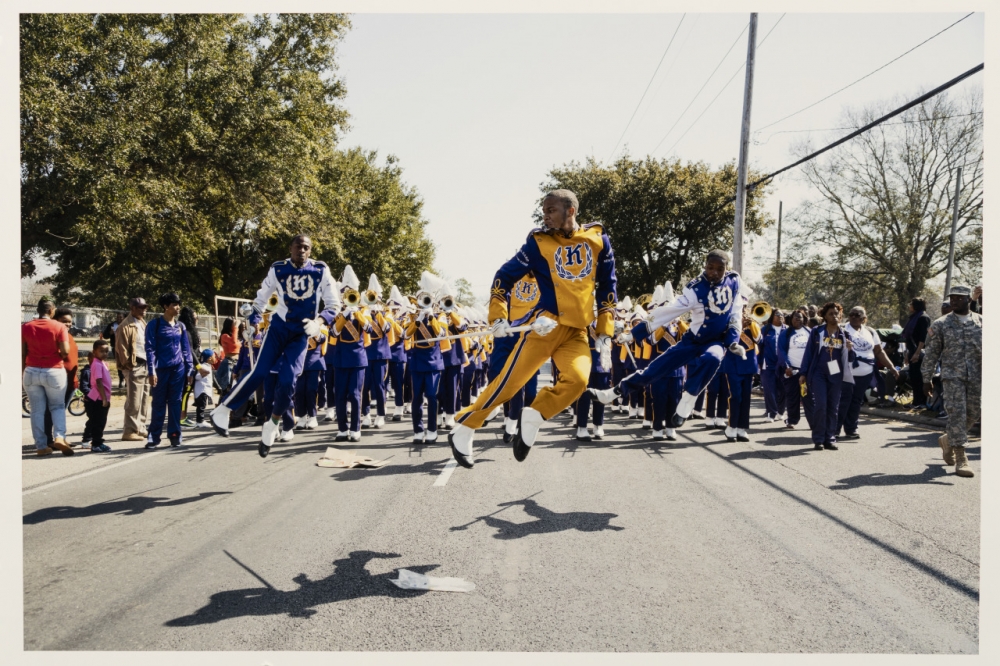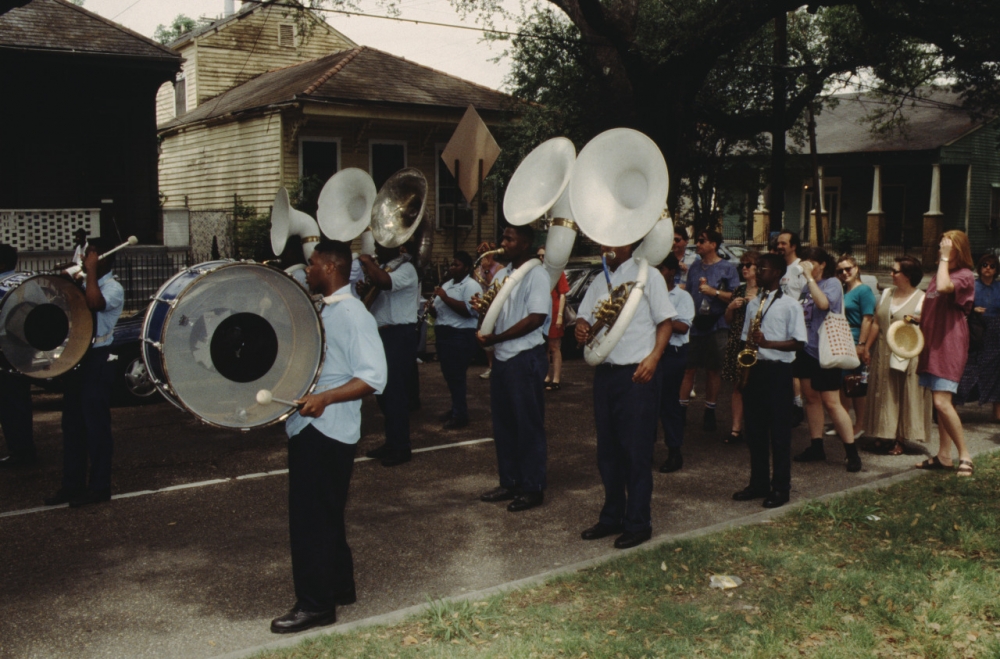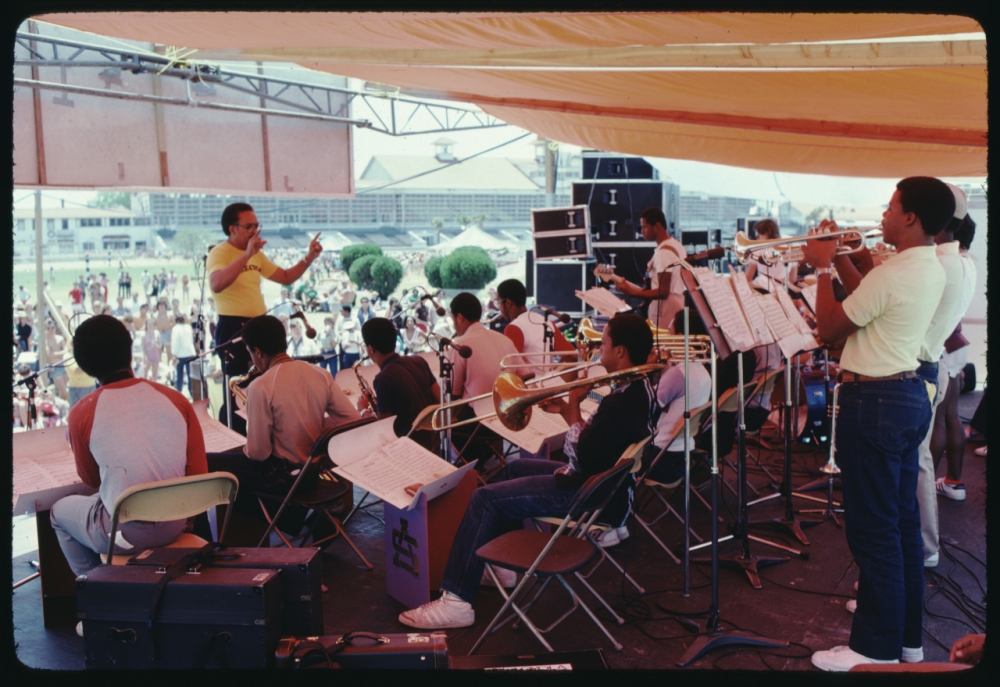In many corners of New Orleans, the start of Carnival isn’t marked by the first king cake or a streetcar parade or a champagne toast, but by a familiar drum count-off and a blast of horns from a nearby school. Marching band practice. If you’re lucky, the bands might even march down your street, giving you a chance to see the kids get their rhythm and sound tighter week by week. Just like at a parade, you hear it before you see it—the signal that Mardi Gras is literally in the air.

Edna Karr’s marching band at NOMTOC in 2015. (THNOC, 2021.0184.1)
The New Orleans marching band tradition spans generations, but the combination of multiple devastating hurricanes, the conversion of the city’s public schools into a decentralized network of charter schools, and an ongoing pandemic have challenged the latest cohort of marchers and music educators like never before. At its 2022 Williams Research Center Symposium last March, presented in conjunction with the exhibition Making Mardi Gras, THNOC welcomed a group of veteran music professionals to discuss these issues and more in a virtual panel titled “Making Marching Bands: How Music Education Creates the Heartbeat of Mardi Gras.” Moderated by Michele Brierre, the founding director of the Ellis Marsalis Center for Music, the panel featured Ellis Marsalis Center music educators Dr. Daryl Dickerson and Dr. Michael Torregano, as well as Adonis Rose, director of the New Orleans Jazz Orchestra. The conversation evolved into a passionate appeal for the city to reverse course on what the panelists agreed has been a disinvestment in music education since Katrina, hastened by the abandonment of a citywide department of music education, a hallmark of the old system.
“You know that saying, ‘The city where care forgot?’” asked Torregano, a former band director at Carter G. Woodson Middle School, Warren Easton High School, Edna Karr High School, and Mississippi Valley State University. “It’s really the city that forgot to care about music. We have to start making an investment in music education in this city. We have to set some standards, we need funding, and we just have to come up with a direction and decide, the music that’s from here—how do we keep that going?”
Dickerson, who was the Livingston Middle School band director for twelve years, noted that the charter system, where parents have limited say in what school their children attend, has created logistical concerns that can make extracurricular activities burdensome on families. “Why does a kid have to go twenty miles from home just to take music?” he asked. “Why can’t the school that’s right around the corner give him music?”
Rose, a graduate of the New Orleans Center for Creative Arts, added: “Without having a unified school district, it really pokes a lot of holes into the success that the band directors and the programs can have.”

Alcée Fortier High School’s band marches in a ceremony honoring Professor Longhair in 1996. (THNOC, 2007.0103.8.3302)
Rubber Band and Bubble Gum
Asia Muhaimin, Warren Easton’s band director for the last 14 years, managed to squeeze in a quick phone call amid a typically frenetic January school day to talk about the state of her music program entering the 2023 parade season.
“It’s kind of funny, but what’s actually bringing them into our band is social media. Kids are watching YouTube videos of bands—put that phone away please—” she laughs as she pauses to gently chide a student in the classroom. “Schools, like Southern, Grambling, TSU, LSU, kids are seeing these bands and it’s sparking their interest: How do I do that?”
Muhaimin’s Warren Easton band will feature ninety marchers this year, almost double what she was working with last year, when parades returned from a one-year pandemic hiatus. She’s added a number of upperclassmen this year, but about fifty of the marchers will be freshmen from the school’s new standalone Ninth Grade Academy. They’re scheduled for six parades, beginning with the Krewe of ALLA on February 10.
“I’m one of those weird crazy teachers who thinks something amazing happens every day,” Muhaimin says. “Like when a kid finally figures out how to play eighth notes correctly, or gets that tone figured out. When the marching band gets something right, I’ll be like, ‘Look at y’all!’ and they’ll laugh at me.”
Muhaimin’s enthusiasm comes from a deeply personal place—she used to be one of those kids, marching at Easton in the ’90s. She’s also relatively rare among current band directors in New Orleans in that she, like Dickerson and Torregano, also has extensive experience teaching before Katrina and the charter school transformation. She’s keenly aware of how things have changed. With the charter system pulling kids in from all over the city, for example, the transportation issues Dickerson mentioned strain her potential pool of marchers. “A lot of the parents don’t feel comfortable with their kids staying late and having to catch the bus home, or maybe they work late or are a single parent,” she says. “Parents are like, ‘If my child can’t get a ride home, they aren’t coming—I need my baby inside safe.’”
She sings the praises of her Easton administrators, but notes that without a district-level music education supervisor, which the city once had, advocating for funding needs amid a “sea of charter schools” is difficult. “But band directors just make stuff work,” she chuckles. “Give us a rubber band and bubble gum and we’ll make a bass drum.”

Members of Warren Easton’s marching band. (Courtesy of Asia Muhaimin)
A Skillset That They Need
During the Symposium panel, Dickerson noted that the top-down leadership of old helped not just with funding, but also with establishing standards and priorities, something the panelists noted has affected the quality of some bands today. “We were held accountable by somebody—Lorraine Wilson, Joe Mills—and they had standards,” he said. “Now the principal controls everything, and they only need band to say they have a band, rather than saying, ‘I have a music program at my school.’”
Muhaimin tries to advocate for other band directors who don’t get the same treatment she does at Easton. “We’re dealing with a lot of things—school performance scores, high-stakes testing—and music educators can get the short end of the stick,” she says. “It’ll be like, ‘I need to pull this student out of band class,’ or, ‘I won’t schedule them in this year.’ That’s a gripe present-day directors have. Scheduling, getting kids into the classroom so they can get proficient on the horn.”
Marching bands, Muhaimin and the panelists point out, offer far more than an extracurricular diversion; they’re often a pathway to higher education. “I always opened my doors when I was a teacher [for auditions], didn’t matter what university you were from,” Torregano said. “I told the kids to audition for everybody . . . and see who is going to present the best opportunity for you.”
Dickerson agreed: “Take the money and go. That’s the pathway I followed. . . . I don’t care if you go to Tulane and play in the pep band or go to Xavier and play in the jazz band—it doesn’t matter. You have a skillset that they need, so use that skillset to your advantage in your education.”
That pipeline continues today. But incoming high schoolers often face a steeper learning curve than before Katrina because there are fewer “feeder programs”—elementary and middle schools with comprehensive music education. “I started out in a concert band at Phillips Elementary,” the Grammy Award–winning Rose said. But he noted that more important than when a student starts is how they are taught.
A student walks past Muhaimin and she lowers her voice. “This student, he gave me hell his freshmen year,” she says, laughing. “Didn’t want to read music or do anything, fought me tooth and nail. He auditioned last week at a program the city put together, and seven universities offered him scholarships. He told me, ‘Alright, you did alright.’”

A high school band performs on stage in 1982. (THNOC, 2007.0103.8)
Sound Good, Look Good
One aspect of New Orleans’s marching band culture has remained constant through the years: the next generation is always listening and watching—especially during Carnival.
“I remember growing up as a kid and being influenced by marching bands in parades,” Torregano said. “We came up in a great generation. You could watch Cohen’s band with director of bands Solomon Spencer, Booker T. with Mr. Chachere, and don’t even talk about John McDonogh with Mr. Sanders. . . . Those bands had great discipline. They always sounded good and looked good.”
Not too long again, Muhaimin experienced what she describes as “the coolest thing to ever happen to me as a band director”—and it didn’t even happen at school. She was standing in line at a sandwich shop when a girl, about nine years old, walked up to her.
“I know who you are and I like your band,” the girl said, “and when I get to high school I’m gonna march for you.”
“That was amazing to me,” Muhaimin says. “I didn’t even have on an Easton shirt. Her mom said all she talks about is wanting to march in my band when she grows up.”
Despite the myriad challenges Muhaimin faces as a music educator today, she says that encounters like that remind her how essential marching bands are to the fabric of the city.
“That’s the kind of stuff that, I mean . . . the marching tradition in this city will sustain on,” she says. “I don’t hope it. It will carry on into the future.”












